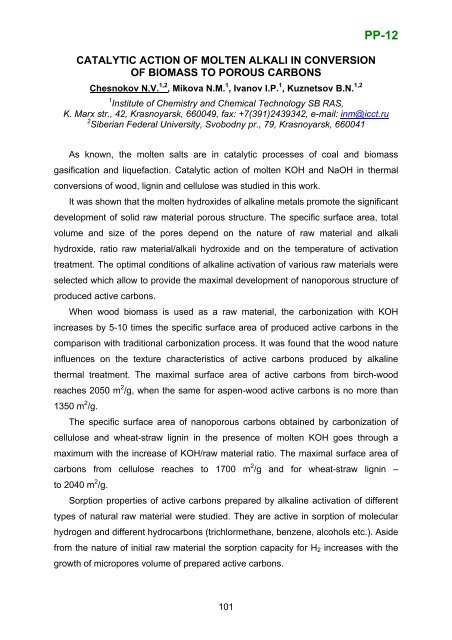Boreskov Institute of Catalysis SB RAS, Novosibirsk, Russia
Boreskov Institute of Catalysis SB RAS, Novosibirsk, Russia
Boreskov Institute of Catalysis SB RAS, Novosibirsk, Russia
- No tags were found...
You also want an ePaper? Increase the reach of your titles
YUMPU automatically turns print PDFs into web optimized ePapers that Google loves.
CATALYTIC ACTION OF MOLTEN ALKALI IN CONVERSIONOF BIOMASS TO POROUS CARBONSChesnokov N.V. 1,2 , Mikova N.M. 1 , Ivanov I.P. 1 , Kuznetsov B.N. 1,2PP-121 <strong>Institute</strong> <strong>of</strong> Chemistry and Chemical Technology <strong>SB</strong> <strong>RAS</strong>,K. Marx str., 42, Krasnoyarsk, 660049, fax: +7(391)2439342, e-mail: inm@icct.ru2 Siberian Federal University, Svobodny pr., 79, Krasnoyarsk, 660041As known, the molten salts are in catalytic processes <strong>of</strong> coal and biomassgasification and liquefaction. Catalytic action <strong>of</strong> molten KOH and NaOH in thermalconversions <strong>of</strong> wood, lignin and cellulose was studied in this work.It was shown that the molten hydroxides <strong>of</strong> alkaline metals promote the significantdevelopment <strong>of</strong> solid raw material porous structure. The specific surface area, totalvolume and size <strong>of</strong> the pores depend on the nature <strong>of</strong> raw material and alkalihydroxide, ratio raw material/alkali hydroxide and on the temperature <strong>of</strong> activationtreatment. The optimal conditions <strong>of</strong> alkaline activation <strong>of</strong> various raw materials wereselected which allow to provide the maximal development <strong>of</strong> nanoporous structure <strong>of</strong>produced active carbons.When wood biomass is used as a raw material, the carbonization with KOHincreases by 5-10 times the specific surface area <strong>of</strong> produced active carbons in thecomparison with traditional carbonization process. It was found that the wood natureinfluences on the texture characteristics <strong>of</strong> active carbons produced by alkalinethermal treatment. The maximal surface area <strong>of</strong> active carbons from birch-woodreaches 2050 m 2 /g, when the same for aspen-wood active carbons is no more than1350 m 2 /g.The specific surface area <strong>of</strong> nanoporous carbons obtained by carbonization <strong>of</strong>cellulose and wheat-straw lignin in the presence <strong>of</strong> molten KOH goes through amaximum with the increase <strong>of</strong> KOH/raw material ratio. The maximal surface area <strong>of</strong>carbons from cellulose reaches to 1700 m 2 /g and for wheat-straw lignin –to 2040 m 2 /g.Sorption properties <strong>of</strong> active carbons prepared by alkaline activation <strong>of</strong> differenttypes <strong>of</strong> natural raw material were studied. They are active in sorption <strong>of</strong> molecularhydrogen and different hydrocarbons (trichlormethane, benzene, alcohols etc.). Asidefrom the nature <strong>of</strong> initial raw material the sorption capacity for H 2 increases with thegrowth <strong>of</strong> micropores volume <strong>of</strong> prepared active carbons.101
















